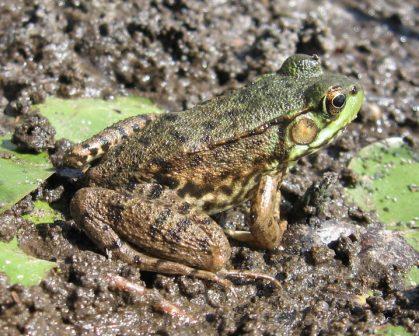Frog Distribution in a Changing Landscape
Feb. 20th 2017“Who will walk between me and the crying of the frogs?” – Edna St. Vincent Millay
The cacophony of a spring night in the northeastern woods can be overpowering. Breeding season for anurans (frogs and toads) is beginning, and males are making themselves heard just like birds singing or bull elk bugling. Gray tree frogs trill and green frogs make a twangy call that has earned them the nickname “banjo frogs.” Wood frogs chuckle like feeding ducks, and above it all trembles the reedy hum of the spring peeper. Step outside your door on a warm April evening in Vermont – especially if you live near water – and this chaos of sound will leave you stunned.
Aside from their biologic function, frog calls offer a powerful source of information for researchers wishing to understand the distribution of anuran species. From 1997 through 2015, the North American Amphibian Monitoring Program (NAAMP) harnessed citizen scientists to survey frogs by listening for their calls along roads during breeding season. These surveys generated distribution maps for 31 frog species across 26 states.
The International Union for Conservation of Nature lists 30% of the world’s amphibian species as threatened, and researchers suspect that land use change – especially increasing urbanization – may be implicated. Seeking to understand what drives spatial patterns of distribution and decline, Marsh et al. used the NAAMP survey data to examine how the effects of road density and land use on anuran species richness vary across regions and at different scales.
Species richness means the number of distinct species in a community or region. While this metric offers only a limited window into the ecological functioning of an area, it is often used as a proxy for biodiversity or habitat suitability. Unsurprisingly, amphibian species richness varies across regions in the United States, since more productive areas – such as temperate wetlands – provide habitats amenable to more amphibian species, with more food, more precipitation, and warmer temperatures. The study corrected for this natural variation in species richness across regions by including local net primary productivity as a covariate.
Some types of land use affect frog species differently across regions. In the Midwest, agriculture was associated with lower species richness, while in the Northeast and Southeast, species richness increased slightly or remained stable in the presence of agriculture. This difference may stem from the different forms agriculture takes in these regions: in the Midwest, massive industrial farms homogenize hundreds of acres, while farms in the Northeast and Southeast tend to be smaller and contain more diverse habitat types. Other land uses had consistent effects across regions: development and impervious surfaces were correlated with low frog species richness, and wetlands meant more frog species.
While rural roads did not affect species richness at the smallest scales (within 300m of survey sites), species richness at larger scales (within 10km from survey sites) declined as the density of rural roads increased. In other words, even if rural roads do not directly kill many frogs, a dense network of small roads can disrupt connectivity or fragment habitat enough to reduce the number of frog species present within a region. Meanwhile, the density of large primary and secondary highways was associated with lower frog species richness at all scales.
_______________________________________
Here in Vermont, recent work has focused on mitigating the latter problem. On “Big Nights,” the first warm, rainy nights of spring, thousands of frogs and other amphibians migrate from forests to wetlands to breed, crossing roads – at their peril – in the process. Bonnyvale Environmental Education Center and North Branch Nature Center, as well as many smaller local groups, organize volunteers to carry amphibians to safety on Big Nights, but more permanent measures are needed to protect the animals from death by car. Two underpasses were recently built on the Monkton-Vergennes Road, and wildlife cameras reveal that hundreds of amphibians are making use of these safe crossings. Structures designed for the passage of fish or other wildlife serve the same function for amphibians elsewhere in the state. Citizens can help by reporting sites where amphibians cross roads en masse to the Vermont Reptile and Amphibian Atlas so that managers can identify hot spots where wildlife culverts should be prioritized. With collaboration between Vermont Fish and Wildlife, VTrans, and town planning departments, wildlife underpasses may soon become more widespread. The wild clamor of spring nights in Vermont may depend on it.
 ecoNEWS VT
ecoNEWS VT